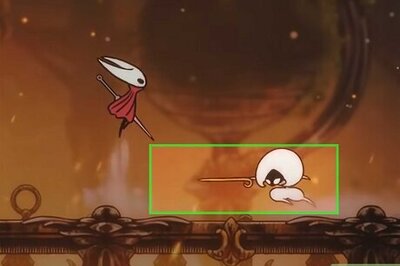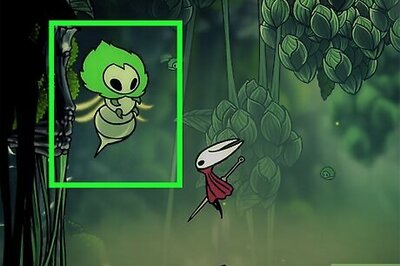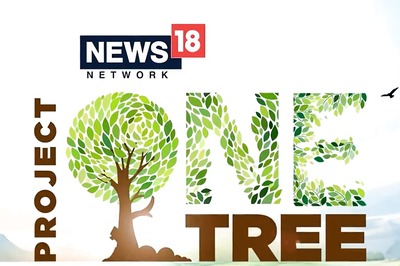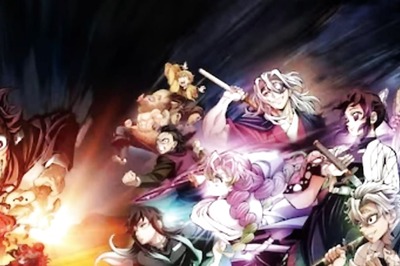
views
Egyptian Symbols & Meanings: An Overview
Symbols like ankh and scarab played a vital role in ancient Egyptian life. There are countless ancient Egyptian symbols that were used to record hieroglyphs, serve as protective amulets, and signify the relationship between people and their gods. Some were protective symbols, like the Eye of Horus, the Scarab Beetle, and the Uraeus. Others symbolized death and rebirth, like the Lotus, the Djed, and the Ba. Still others were ascribed special meanings in the everyday lives of ancient Egyptians, which we’ll describe in detail through the lengths of this article!
57 Famous Ancient Egyptian Symbols
Akhet Akhet (sometimes referred to as ajet) is a hieroglyph used to represent the sunrise and the horizon. The hieroglyph pairs a sun and sloped symbol to represent the natural phenomena. The akhet was a common shape of choice for amulets, and ancient Egyptians wore these amulets to represent the rebirth of the Sun every morning, which was spiritually tied to their own life journeys and continual rebirth.
Amenta Amenta represented the land of the dead (or the afterlife) in ancient Egyptian culture. Amenta is believed to be a spiritual and sacred place where souls journey after death in order to transform and eventually be reborn. Symbolically, the amenta symbol can be used to represent spiritual initiation, transformation, and connection to the subconscious realms of existence. The symbol was originally connected to the place where the sun sets into the horizon, but it’s come to represent the western bank of the Nile (where Egyptians buried their dead).
Ankh The ankh is arguably the most recognizable and powerful symbol in ancient Egypt. The ankh symbol generally represents the concept of eternal life, and it often appears in tomb paintings and other artworks related to this symbolism. Also referred to as “the key of the Nile,” this symbol is thought to represent the union between Osiris and Isis—the ancient Egyptian god of the dead and goddess of magic (among other things), respectively. Fittingly, the ankh is also used with the cult of Isis, who was the queen goddess of ancient Egypt.
Akh An akh is a symbolic representation of the spirit of a deceased person. More specifically, the akh is the transformed soul of someone who has passed through the afterlife process, been judged, and has now been deemed capable of interacting with the living world. These souls often have supernatural powers and are linked to the “ka” (life force) and “ba” (personality) as the parts that make up a whole soul.
Atef The atef is a symbol that’s distinctly associated with Osiris, the ruler of the underworld in ancient Egyptian mythology. The atef is a feathered crown worn by Osiris in his role as king of the afterlife. The crown features a tall white centerpiece framed by two colorful ostrich feathers. Symbolically, the crown represents truth, justice, and the unification of the two regions of Egypt.
Ba Ba is the Egyptian concept most directly related to the soul. It’s considered the most significant part of each individual person that is connected to them even before birth. After death, the ba is said to detach from the body and ascend to the sky. From then on, the ba can visit the world of the living during daytime and the world of the deceased at night. As a symbol, it’s usually visually represented by a bird with a human head, which symbolizes its ability to travel between different realms.
Bee and Reed The bee and the reed are two symbols that together represent the unity of Upper and Lower Egypt, as well as the overseeing power of the pharaoh. The bee represented the King of Lower Egypt and originally represented royalty and religious significance. The reed, on the other hand, symbolized the King of Upper Egypt. As a combined symbol, ancient Egyptians used the bee and the reed to represent the unity of Egypt’s two regions and the power of the pharaoh in ruling over both of these areas. The bee as a standalone symbol had other varied meanings, including wealth, military power, and a representation of the goddess Neith (who was associated with creation and warfare).
Bennu Bird The bennu bird was an Egyptian symbol representing creation and rebirth. According to Egyptian myth, the bennu bird was the first living creature, whose cry was said to have marked the beginning of time. Due to its ability to rise from its own ashes, as well as its association with Osiris (king of the underworld), the bennu came to represent rebirth. This symbol was also closely associated with the sun—another symbolic form of rebirth—as the bennu was viewed as the soul of the sun god Ra that rose from its own ashes as the sun rose in the sky each day.
Benben The Benben (or primordial hill) was a sacred stone kept in a Heliopolis shrine, but it was also worn as an amulet and depicted in tombs and on temple walls and sarcophagi. While no one knows what happened to the original stone, illustrations suggest it was pyramid-shaped. In some versions of the ancient Egyptian creation myth, the Benben was the first piece of earth to emerge from the waters of chaos (aka the primordial waters of Nu). From this stone, the creator god Atum began the process of creation.
Canopic Jar The canopic jar in ancient Egypt symbolized the protection of a deceased person’s organs in the afterlife. The jars were literally used to store the vital organs of a person (liver, lungs, stomach, intestines) after their removal during mummification. Each jar was topped with the head of one of the Four Sons of Horus, each of whom represented a specific organ and was thought to protect that organ so that the deceased could function properly in the afterlife. The Four Sons of Horus are Hapy/Hapi (protector of lungs, represented by a baboon head), Imsety (protector of the liver, represented by a human head), Duamutef (protector of the stomach, represented by a jackal head), and Qebehsenuef (protector of intestines, represented by a falcon head).
Cartouche The cartouche in ancient Egypt is a hieroglyphic symbol that has an oval shape with a horizontal line at one end. Functionally, the cartouche was used to identify a certain king or another important member of society—the information in the oval would identify that individual, and the cartouche would be inscribed onto their tomb and belongings. Symbolically, the cartouche mainly represented protection. The horizontal line and oval shape represented a rope to protect the person identified inside the oval. The shape was also believed to represent the enclosure of the sun around this individual and the king’s power over the universe.
Crescent The crescent moon has a variety of meanings across different cultures and belief systems—in ancient Egypt, the crescent moon specifically represented the moon god Khonsu. It also symbolized protection, healing, and the lunar cycle. Specifically, the crescent represented the phase of the lunar cycle associated with fertility and rebirth.
Crook and flail The crook and flail is a dual symbol that represents the power and authority of the pharaoh. The crook represents the king’s role as a shepherd in protecting his people, while flail symbolizes the fertility of the land. Both of these symbols were originally associated with the afterlife god Osiris. Together, they represent the pharaoh's divine right and duty to rule over and care for the Egyptian people. The crook and flail are sometimes referred to as the hekha and nekhakha.
Deshret (Red Crown) The deshret or “red crown” symbolizes rule over Lower Egypt, as opposed to Upper Egypt. Pharaohs would wear this crown to showcase their authority over the northern part of Egypt. The crown itself was said to be a gift from the earth deity Geb to the god Horus, so pharaohs wore this crown as a way to assert their descendancy from Horus and divine right to rule over Egypt.
Djed Pillar The djed (or djed pillar) is associated with stability, rebirth, and regeneration. It was primarily associated with Osiris, the Egyptian god of the deceased, and was said to represent his human backbone and his resurrection. As a result, the symbol was often used in resurrection spells and also to represent the enduring presence of the gods throughout people's lives and rebirth after death.
Djew The djew symbol in ancient Egypt most clearly represents a mountain and is depicted as two peaks with a value between them. This symbol is thought to symbolize a cosmic mountain range that holds up the heaven. The eastern and western peaks of this mountain are called Bakh and Manu, respectively, and the valley in the middle is largely believed to be the Nile valley. Djew is also associated with the afterlife due to the location of many Egyptian burial sites in mountainous zones.
Duat Duat is a representation of the underworld in ancient Egyptian mythology. The symbol or hieroglyph that represents duat is depicted as a star inside of a circle—sometimes called the seba symbol. In duat, deceased souls are said to face trials and judgement before continuing onto their final destination. Along their path through duat, they may have to encounter various gods and goddesses and navigate through different regions—the outcome of this journey will determine each soul’s eternal fate.
Eye of Horus The Eye of Horus symbolizes healing, protection, and divine intervention. Also known as the “all seeing eye” or the “udjat,” the Eye of Horus stemmed from a myth where the god Horus loses an eye in a battle with the god Set. Later in the myth, Horus’ eye is restored by the goddess Hathor—as a result, the eye came to symbolize the process of healing and restoring wholeness. This symbol is often worn as a protective amulet used to ward off evil and protect from harm, especially during funerary practices. The Eye of Horus is usually stylized as a left eye, with its right-eyed counterpart being the Eye of Ra.
Eye of Ra The Eye of Ra is a powerful symbol with a variety of meanings, including power, protection, and healing. Like the Eye of Horus, the Eye of Ra is known as an “all-seeing eye” and is believed to protect against evil due to its association with the sun god Ra. It’s also associated with healing and good health, as well as the royal power of pharaohs and rules. The Eye of Ra may also represent fury and violence, likely due to its mythical origins. Ra once sent his daughter to punish his disrespectful followers. Since the eye is sometimes depicted as the embodiment of this daughter, it came to be associated with violence and power in some contexts.
Falcon The falcon is an Egyptian symbol associated with Horus, god of kingship, healing, protection, the sun, and the sky. The bird represents divine presence in the natural world, specifically divine kingship and the divine authority of the pharaoh—who’s seen as an earthly representative of Horus. As the falcon flies high above the earth, the pharaoh is similarly granted an elevated status over the realm and its peoples. The falcon may also symbolize vigilance and speed due to its keen sight and flight, while its eyes symbolize the sun and the moon.
Feather of Maat The feather of Maat represents truth, justice, and cosmic order. The feather is associated with the goddess Maat, who serves as the personification of truth, cosmic balance, and justice. Maat is traditionally depicted with an ostrich feather, which is said to represent the truth. Most significantly, the feather is used in afterlife judgement—the deceased’s heart is weighed against the feather to determine if they’ve lived a righteous life. If the heart is lighter than the feather, they are permitted to enter the afterlife. In some depiction, Maat was shown to use a set of scales (known as the Scales of Maat) instead of her feather to weigh the hearts of the deceased.
Feather of Shu The feather of Shu represents lightness and emptiness due to its association with the god Shu—the god of air and wind. Shu is traditionally represented with an ostrich feather on his head, so the feather itself symbolizes his personage and his power over the air. The feather also serves as the hieroglyph for the god’s name, as opposed to the written letters.
Hedjet (White Crown) Hedjet is the “white crown” of Upper Egypt. The crown was worn by pharaohs to showcase their divine right to rule over the southern region of the country. When worn in conjunction with the deshret (or “red crown”), these two symbols form the pschent or “double crown,” which symbolizes the unification of Upper and Lower Egypt under a single ruler. The hedjet is depicted in a conical shape with ear cutouts.
Hennu Boat The hennu boat—also known as the solar barque or sokar barque—is a sacred vessel of the god Seker. The boat itself symbolizes the journey of a deceased pharaoh through the underworld and into the afterlife. Visually, the hennu boat is traditionally depicted as moving across the sky alongside the sun god Ra, signifying the sailing journey to the eternal realm after death. Festivals dedicated to Seker, an Egyptian god of the dead, often involved celebrators placing a stone (representing the god) onto a Hennu boat and pulling it through fields while wearing onion garlands.
Ibex The ibex was a symbol of good fortune and renewal in ancient Egypt—the creature’s mountain-dwelling nature connected it to regeneration and its physical representation was often used as a good luck charm. It also represented the cycle of life and, in particular, the occasion of the new year. As a result, the ibex is frequently featured on New Year’s gifts and decorations.
Ieb The ieb (or leb) was the ancient Egyptian symbol used to represent the heart. Associated with the heart, the ieb also symbolized the center of life, intelligence, emotions, and morality. According to ancient Egyptian beliefs, the ieb (or heart) was weighed against the feather of Maat after death to determine one’s faith in the afterlife. Therefore, the ieb became a longstanding symbol of prosperity and good fortune in eternal life. They were often carved into amulets and placed on the deceased during burial to protect their heart in the afterlife. “Leb” is the term used to refer to the hieroglyphic symbol representing the heart, while “ieb” is the literal Egyptian word for “heart.”
Imiut An imiut in ancient Egypt is a sacred object made of a stuffed, headless animal skin that was fastened to a pole and placed in a jar of ointment. The object typically represented a cat or bull and was associated with the god Anubis to represent his role in preparing deceased souls for the afterlife. These objects—also known as imiut fetishes—were typically placed around sacred spaces or within tombs to protect the dead.
Ka The ka is a part of the soul concept in ancient Egyptian beliefs—specifically it’s the part of a soul that distinguishes a living person from a dead one. Represented by a hieroglyph of uplifted arms, this life force or spirit was thought to come into existence at the moment of birth and continue living on after death. The ka was often visualized as a slightly smaller doppelganger of the living person and could reside in the person’s statue or picture.
Khepresh (Blue Crown) The khepresh symbol in ancient Egypt was representative of the “blue crown” or “war crown.” This crown was worn by pharaohs to showcase their power, authority, and divine right to rule as successors of gods like Horus and Ra. It was most often worn during battle, with its helmet-like appearance symbolizing military prowess and its blue color symbolizing a connection to the heavens.
Khet A khet in ancient Egypt is a term used to refer to the physical body, or the part of the soul that would be judged in the afterlife. This physical body or earthly form is required for the soul to receive judgement in the afterlife. The khet is usually depicted as a set of steps which symbolize the pathway to the gods or the journey to the afterlife.
Kneph Kneph is a motif of divinity who may be represented as a winged egg or as a globe surrounded by serpents. Kneph is also a god who’s typically depicted with a ram’s head and who symbolizes the creative force of the universe. This creative force includes the concept of air, wind, and the breath of life—all of which tie this symbol to the significance of the creator god and the creation of life.
Lotus The lotus flower (or “sesen”) had many symbolic meanings in ancient Egypt, the most important being creation and rebirth. The rebirth significance stems from the flower’s opening and closing with the sun, while the creation symbolism originates from a myth of a giant lotus flower growing out of a pond and spawning the sun. The lotus was also representative of Upper (southern) Egypt, while papyrus represented Lower (northern) Egypt. Other symbolic meanings of the lotus flower include the sun, immortal life, and spiritual enlightenment.
Medjed Medjed is an obscure Egyptian god who’s represented by a ghost-like symbol with legs and eyes. Known as the “smiter” or the “subduer,” this deity is often portrayed as an unseen entity that shoots rays of lights from his eyes. In essence, he strikes down upon or smites others without being seen, giving him the presence of a powerful and protective god.
Menat A menat is a beaded necklace that symbolizes fertility, good health, and protection against evil spirits. Associated with love goddess Hathor, the necklace was considered a symbol of divine favor bestowed on women and men that were especially fruitful or virile. The menat was typically worn as an amulet and was sometimes interred in burial sites to protect the deceased.
Nebu Nebu is the Egyptian symbol for gold, depicted as a golden collar with dangling ends and seven spines hanging from the middle. In ancient Egyptian culture, gold was a divine metal believed to be sent from the heavens. It was usually associated with the sun god Ra and used to symbolize immortality and prosperity due to its destructive nature and the wealth it represented.
Nemes Headdress The Nemes headdress is a cloth headdress with alternating blue and gold bands. This headdress was believed to connect the pharaoh—who wore the headdress—to the powerful god Horus. The garment itself was thought to symbolize the pharaoh's journey from earthly life to the afterlife, while its lion’s mane shape represented the pharaoh’s status as king of all humans.
Nile River The Nile River was a crucial part of ancient Egyptian culture, both for its symbolic importance and its role in providing sustenance and prosperity to the Egyptian peoples. As a symbol, the Nile represented life, fertility, and abundance. It was believed to be a “gift from the gods” and was particularly associated with the god Hapi, who was depicted with a large belly that represented the river’s floodwaters and the ensuing fertility of Egyptian lands. The Nile is also closely tied to the ankh symbol, which is sometimes called the “Key of the Nile.”
Numbers In ancient Egypt, numbers were represented by symbols—each of which represented a power of 10 (also known as a base-ten system). “1” was represented by a single stroke, “10” a heel bone, “100” a coil or rope, “1,000” a lotus flower, “10,000” a pointed finger, “100,000” a tadpole, and “1,000,000” an image of a man with raised arms.
Obelisk The obelisk was an important figure in ancient Egypt and was revered as a monument and spiritual representation. Obelisks were used to commemorate the dead, represent kings, and honor important gods. The structures were carefully structured, arranged, and inscribed with details that would allow onlookers to fully understand the meaning of the obelisk and the story it told. Symbolically, obelisks also signified immortality, divinity, and the continuity of the pharaoh’s rule.
Ouroboros The ouroboros symbol is depicted as a serpent with its tail in its mouth. Its most prominent significance is as a symbol for the divine cycles of life, death, and rebirth. The snake’s circular movement represents the circular movement through life, while the shedding of its skin symbolizes the way that souls transform throughout this cycle. The ouroboros may also symbolize the unity of all material and spiritual items and concepts, all of which are believed to perpetually transform but never disappear from the universe.
Papyrus The papyrus was used functionally as a writing material (like paper) in ancient Egypt. It was made from the pith of the papyrus plant and was used to record religious and legal texts. On a symbolic level, the papyrus was a symbol of Lower Egypt, while the lotus flower represents Upper Egypt. Papyrus was also used in death rituals as a symbol of rebirth and as a symbol for the word “growth,” which was represented by the papyrus stem hieroglyph.
Pool The pool symbol in ancient Egypt represents water, unsurprisingly, but specifically the waters of Nun. Nun is a term referring to the primordial waters believed to be the source of all creation in Egyptian myth. The symbol is typically drawn as a rectangular shape with seven vertical zigzag lines inside.
Pschent (Double Crown) The pschent is a double crown in ancient Egyptian culture that represents a pharaoh's divine rule over both regions of the country. The pschent crown combines the deshret (red crown) of Lower Egypt and hedjet (white crown) of Upper Egypt to showcase the pharaoh’s power over a unified Egypt. The crown itself bears two animal emblems: an Egyptian cobra and a vulture.
Rekhyt bird The rekhyt bird symbolizes the common people of Egypt and the love they hold toward their ruler. The bird is typically depicted with its wings crossed behind its back and arms raised in worship. It may be depicted alongside subjects of the king that are bowing down in adoration and submission to him. The rekhyt bird also sits on baskets, the hieroglyph for which means “all,” and below a sky of stars, the hieroglyphs for which mean “adoration.”
Sa The sa symbol is a hieroglyph signifying divine or magical protection. The symbol’s shape is a looped rope knot, similar to a life preserver, that appears often in amulets, jewelry, and carvings. The sa amulets were believed to provide safety and well-being for both living and dead souls, and they were particularly associated with Tawaret—the goddess of childbirth and fertility.
Scarab The scarab beetle is an incredibly important Egyptian symbol that represents rebirth, resurrection, and good fortune. Ancient Egyptians believed that the sun god Khepri pushed the sun across the sky each day in a giant scarab beetle—similar to how the scarab beetle rolls dung into a ball. Due to the sun’s strong association with rebirth, scarabs consequently took on the same meaning. Bodies of the dead were adorned with scarabs, and scarab amulets were also worn for good luck and protection by the living.
Sekhem Scepter The sekhem scepter was a ritual scepter used in ancient Egypt. The scepter is usually depicted as a flat paddle on a papyrus stalk handle. It was viewed as a symbol of power and authority, and its image is often incorporated in names and words associated with control and might. For instance, it appears in the written form of names of pharaohs like Sekhemkhet and deities like the lioness goddess Sekhmet.
Sema-Tawy The sema-tawy (or simply the ‘sema’) is a hieroglyph used in words like “unification,” “unite,” and “unify.” It principally represents the unification of Upper and Lower Egypt and often appears in artworks that depict this event. The symbol itself is depicted as an animal’s lungs and windpipe wrapped with lotus and papyrus plants. These plants represent the symbols of Upper and Lower Egypt, visually signifying their unification.
Shen The shen is a ringed symbol that represents protection, infinity, and completeness. The shen ring is a circle with a tangential line, stylized in hieroglyphs as a loop of rope. As the symbol encircles itself, it’s thought to bestow eternal protection thanks to the protective nature of the gods. The shen is often worn as an amulet or on tombs and sarcophagi, but it may also be exchanged between couples as a romantic love token to mark special occasions.
Sistrum The sistrum is a musical instrument and symbol in ancient Egypt that represents joy and fertility. Not just any instrument, the sistrum was a sacred object used in dances and religious ceremonies—specifically in the worshiping of the goddess Hathor. As Hathor is often depicted with a horned cow head, the U-shape of the sistrum is thought to represent this shape. The sistrum borrows much of its symbolism from Hathor’s own associations, such as motherhood, eroticism, and joy.
Tree of Life The tree of life is an important symbol that’s been used and honored in many cultures—ancient Egypt included. To the ancient Egyptian peoples, the branches of the tree of life represented the heavens and coming abundance. The roots, alternatively, represented death as their tendrils reached into the earth. The tree of life was also thought to be the home of the bennu bird, which represented creation and rebirth.
Tyet The tyet is an Egyptian symbol similar to the ankh, as it resembles a knotted piece of cloth with the arms curled down. Also known as the “knot of Isis,” the tyet symbolizes protection and fertility and is translated to mean “life” or “welfare.” Some research indicates that the tyet may have originally been a knot of cloth used to absorb menstrual blood, but it’s not certain that that’s the origin of this symbol.
Uraeus The uraeus is represented by a rearing cobra and symbolizes royalty, divinity, and sovereignty. The standing position of the cobra is meant to convey protection over the pharaoh as well as the ruler’s divine authority as the leader and protector of Egypt. The uraeus is also viewed as a representation of Wadjet, an Egyptian snake goddess and the protector of Lower Egypt.
Ushabti An ushabti is a small funerary figurine that represents a servant for the deceased in their afterlife. These figurines were placed among grave goods in ancient Egyptian tombs and believed to help the deceased to complete tasks after their death. The figurines themselves usually appeared as mummified human figures with their arms crossed over their chests. They were most often made of wood, stone, and faience.
Vulture The vulture was a symbol of protection, motherhood, and the cycle of life in ancient Egypt. The ancient Egyptians also worshipped a vulture goddess known as Nekhbet, who was said to protect the pharaoh with her vulture wings. Her vulture headdress was seen as a symbol of maternal protection and was often worn by female pharaohs and royal wives. It was also believed in ancient Egypt that all vultures were born female and without male intervention. Because of this idea, as well as the vultures’ habit of eating carrion, they were thought to be transformative figures representing death and rebirth. Alongside these meanings, vultures were thought to protect children and were considered sacred to the point that killing one was punishable by death.
Was Scepter The was scepter is an ancient Egyptian scepter and symbol that represents royal authority and divine dominion. Often appearing in ancient relics, artwork, and hieroglyphs, the scepter most often appeared as an animal ahead atop a long staff with a forked end. Since it was usually shown in the hands of gods like Set and Anubis, it conveys a sense of control over the chaos of the world.
Winged Sun The winged sun is a symbol that contains a circular sun framed by two cobras and three sets of symmetrical wings. The symbol’s main significance is as a symbol of royal dignity and power. It also represents the divine eternal soul without a physical form—the wings represent power, mourning, and resurrection, while the feathers represent good words, thoughts, and deeds. The symbol is mainly associated with the god Horus.
What were Ancient Egyptian symbols used for?
These symbols were largely used as the main writing system. Hieroglyphic symbols were used as a written form of the ancient Egyptian language. These symbols were used on temples and tombs as well as throughout artistic pieces and architectural designs—like jewelry, pottery pieces, statues, and amulets. The symbols were used to show concepts and emotions, and they were especially important in a society where most citizens couldn’t read or write. Thanks to the use of Egyptian symbols, lower classes without a formal education were able to understand and pass down stories and cultural norms. Symbols weren’t only used as a way for ancient Egyptians to communicate with each other, but also as a way to communicate with gods. As a result, subsequent generations and modern historians were and are able to understand the spiritual world and beliefs of ancient Egyptians.
The symbols also played a key role in religion and afterlife beliefs. Ancient Egyptian symbols and hieroglyphics were often referred to as the “words of the gods,” and many Egyptians believed that these symbols carried a powerful force that connected them to the heavens and to the natural forces around them. As a result, these symbols were an important foundation of the ancient Egyptians’ religious beliefs and were often carved and incorporated into religious objects like amulets, statues, paintings, carvings, and temples. Unsurprisingly, ancient Egyptian symbols played an important role in religious rituals and were often held by pharaohs and high priests during their religious work. In particular, certain symbols were used during funerary rituals and other practices related to the afterlife. The concept of death and rebirth is crucial to ancient Egyptian beliefs, and symbols were used to guide deceased souls on the start of their new journey into the afterlife. Protective symbols like the Eye of Horus may have been used to protect the deceased after death, while symbols associated with certain gods or goddesses may have been used to invoke that deity’s help. But how were these symbols bestowed in death? For the most part, they were carved into amulets and talismans and placed in the tomb or buried with the deceased. Symbolically, they were meant to ensure that the deceased person had a prosperous start to the next phase of their journey through life and death.
Ancient Egyptian Symbols, Gods, & Goddesses
Each Egyptian symbol was thought to reflect the gods’ power and wisdom. Hieroglyphics and Egyptian symbols were viewed as divine powers delivered from the heavens. They were used to communicate with the gods, and ancient Egyptians also used them to convey how they thought about the gods and their actions. Certain symbols were specifically connected to specific gods—for example, the Eye of Ra represented the eye of the powerful sun god. His eye was often drawn on temples and tombs to safeguard against evil. Other symbols were closely connected to divine powers. The Ankh, for instance, symbolizes life and life after death. Similarly, Scarab Beetle represents resurrection, while the Bennu Bird conveys the cycle of birth, death, and rebirth.
Commonly Used Materials in Ancient Egyptian Symbols
Many ancient Egyptian symbols were made of stone, metal, and wood. The most common material used to represent ancient Egyptian symbols was stone, as stone is highly durable and long lasting. Hieroglyphs and other symbols were carved into stone temples, tombs, and more. Different varieties of metal were also commonly used. Gold, lapis lazuli, electrum, silver, and bronze were frequently used to carve symbols into amulets that were thought to offer protection to their wearers. Household items and day-to-day objects—like furniture, tools, beads, figurines, and some amulets—were usually made out of wood or faience (a ceramic material). Papyrus was also sometimes used in the same way that paper is used in modern times. Ancient Egyptians would record symbols and hieroglyphics onto papyrus scrolls. Typically, stones and metals were used for objects that were meant to stand the test of time, while wood or papyrus would be used for smaller, everyday objects that one would carry around or move often. And, of course, the material used sometimes simply depended on the resources available to the carver or creator.
Frequently Asked Questions About Egyptian Symbols
What is the Egyptian symbol for good luck? The cartouche is the clearest Egyptian symbol for good luck, although the ankh may also signify protection and good fortune. The cartouche connects to the sun and is believed to provide divine protection against evil spirits. The ankh and scarab are also used as symbols of good fortune and protection.
What’s the Egyptian symbol for love? The lotus flower and shen ring are both associated with love. The lotus flower symbolizes creation, life, and rebirth, while the shen ring is used as a romantic token of eternal and infinite love (similar to a modern wedding ring!).
What’s the Egyptian symbol for death? The scarab beetle is the most commonly recognized symbol for death in Egyptian culture. The scarab symbol represents rebirth and renewal and it was frequently worn as an amulet by both the living and the dead.
What are the most powerful Egyptian symbols? Some of the most powerful symbols in Ancient Egyptian culture include the ankh, the Eye of Horus, the crook and flail, the djed, the was scepter, the uraeus, and the scarab beetle. These symbols were frequently used in Egyptian artwork, architecture, and sarcophagi inscriptions.
What is the most sacred Egyptian symbol? While there are many sacred Egyptian symbols, one of the most prominent is the ankh. It most clearly represents ancient Egyptian religious practices, as well as their understanding of the cycle of life and immortality.



















Comments
0 comment